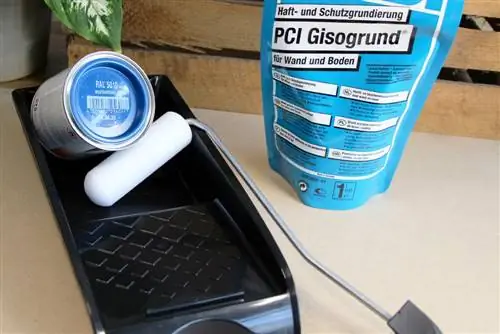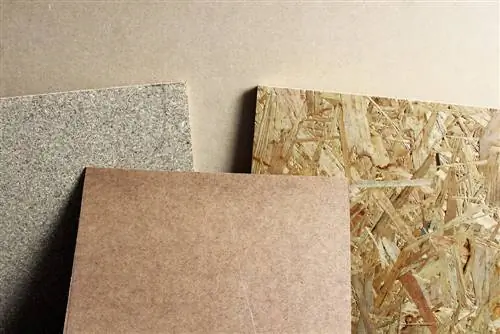- Author admin [email protected].
- Public 2023-12-17 03:39.
- Last modified 2025-06-01 06:48.
Furniture, loudspeaker boxes, toys or even entire partitions: MDF panels - medium-density fiberboard - are extremely versatile. With the right preparation, the inexpensive wood material can be painted so that no wood structure can be seen later. However, this requires extensive preparatory work because simply painting is hopeless due to the high absorbency. Before painting with wall paint, you have to compact the panels so that the paint sticks.
Never paint MDF boards without preparatory work
MDF boards are boards made of pressed wood chips mixed with adhesives. Softwoods such as spruce or pine are primarily used, but poplar, birch and beech are also often used. The panels are extremely robust, very stable and flame-retardant, but at the same time inexpensive and easy to process. However, due to the smooth surface and the processing of fine wood particles, MDF panels are highly absorbent - if you painted them with wall paint without careful priming, you would at best achieve a very irregularly stained result, even after several work steps.
Painting with wall paint doesn't always make sense
Also remember that painting with wall paint does not always make sense. If the MDF board painted in this way is later to be placed in a rather damp environment - for example in the kitchen, in the bathroom or on the terrace - it is clearly not advisable to use wall paint as a coat of paint. Interior dispersion, as wall paint experts also call it, does not make the material waterproof, even with several layers of primer. As a result, kitchen fronts or bathroom cabinets that were simply coated with wall paint and made from MDF panels would swell after a short time and become unusable.
If you are planning such a project, it is better to use paint. In this case, seal the panels completely in several layers with a high-quality varnish. Acrylic varnish is very suitable for this purpose.
Materials and tools
If, on the other hand, the MDF panels are to be used in living rooms without high levels of moisture - for example because you want to install them as a partition or hang a ceiling - you can confidently use wall paint. You should have the following materials and tools ready:
- MDF panels of the desired size and thickness
- Foundation
- Insulating primer / insulating filler
- if necessary, wallpaper, wallpaper paste
- wall color
- Brush, foam roller
- flat color tray
- clean microfiber duster
- Spatula and ready-made filler (for wood and MDF)
- Sandpaper of different fine grain sizes (between 180 and 300)
- Orbital sander / eccentric sander
Which materials are suitable for priming MDF boards?
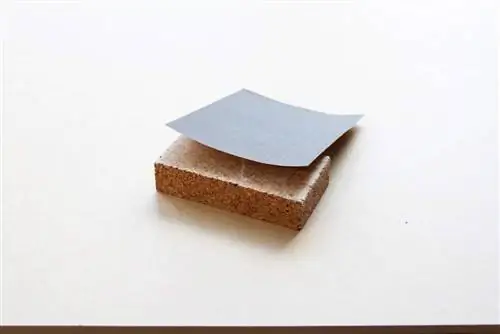
The right primer is extremely important for the success of the project. Without this, the fiberboard will continue to absorb the paint, and not every type of primer is suitable for the same reason. You need a material that closes the fine capillaries quickly and sustainably - a conventional deep primer is not sufficient in many cases.does not provide satisfactory results. It is therefore better to use a so-called isofiller, also known as insulating filler or insulating primer. This is applied in at least three layers and ensures that the panels no longer absorb any paint.
Tip:
White primer makes light colors shine better, black primer, on the other hand, is suitable for a dark coat, for example in a dark violet or anthracite.
Costs
Even if the MDF boards themselves are quite cheap, the materials for priming and sealing are not necessarily so. 750 milliliters of insulating primer cost between 20 and 25 euros, ready-made filler for MDF boards (400 grams) costs around five to ten euros. High-quality wall paint costs around 25 euros per 2.5 liters, whereas sandpaper sets with different grain sizes only cost just under one to two euros. However, you do not have to buy orbital or eccentric sanders; you can also rent the devices on a daily basis from a hardware store for little money.
Tip:
Although an eccentric sander delivers better results, it is only recommended for experienced craftsmen. Orbital sanders are slower and therefore easier to use.
Painting MDF panels with wall paint - instructions
You can paint MDF panels with wall paint in five basic steps, whereby you should repeat each of these steps up to three times.
Dedusting and cleaning
Although many instructions for painting MDF boards usually mention sanding as the first step, this step is actually not necessary. The roughening is intended to make the material absorbent for the primer, but MDF boards are naturally absorbent enough. Therefore, skip this step and first carefully dust off the plate with a microfiber cloth. Any dust must be removed otherwise the end result will suffer. If necessary - for example with used MDF boards - you can also clean them with a grease remover.
Tip:
Sand the edges and corners of the panels before priming and clean them carefully. If these remain unbroken, the paint will chip off easily later.
Prepainting and priming
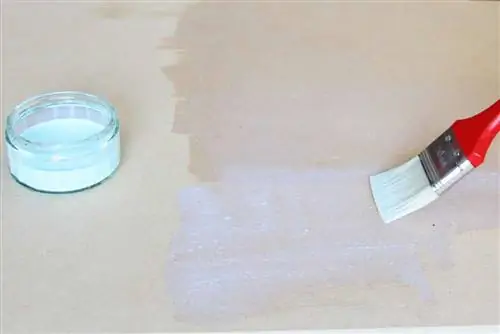
Once the plate has been thoroughly cleaned, you can now treat it with the primer. Which one you use depends primarily on the processing of the panels. You should first work on coarse MDF boards with a ready-made filler so that you get a smooth surface. If the material is very fine, simply paint it with insulating primer.
Sanding MDF boards
After the primer has dried, sand the fiberboard. Start with 180 grit for coarse boards and 240 grit for fine ones. After each sanding step, coat the MDF boards again with the primer, let it dry and use a finer grit for each subsequent step. Don't forget to thoroughly remove dust from the plate after each sanding.
Wallpapering
You can then wallpaper the well-prepared panel, for example with white woodchip wallpaper. This step is not absolutely necessary, but it makes it easier for you to paint the wall later - after all, the paint adheres better to the wallpaper and penetrates the surface less. However, keep in mind that you may need more wallpaper paste than usual.
Painting and sanding
Once the wallpaper has dried, the final step follows: painting. To do this, pour the liquid paint into the shallow bowl and wait until any bubbles have settled. Use a foam roller to pick up paint, but not too much - you don't want it to drip as this will leave unsightly stains on the surface. Instead, rub the roll against a paint grid. For an even result, always stroke evenly and with long strokes in one direction, never in a crisscross manner. Allow the paint to dry carefully, then sand it as described for the primer and apply another layer of paint. As a rule, a rich color result is achieved after three layers of paint. Do not sand again after the last application of paint.
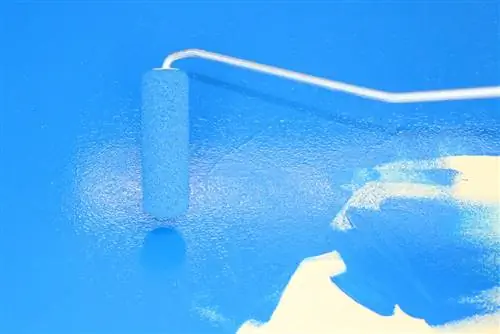
Tip:
To protect the paint from scratches and moisture, you can apply clear varnish as a final finish. To do this, lightly sand the final layer of paint and apply at least two coats of clear varnish with a clean foam roller or spray can. The individual layers should dry thoroughly in between.

